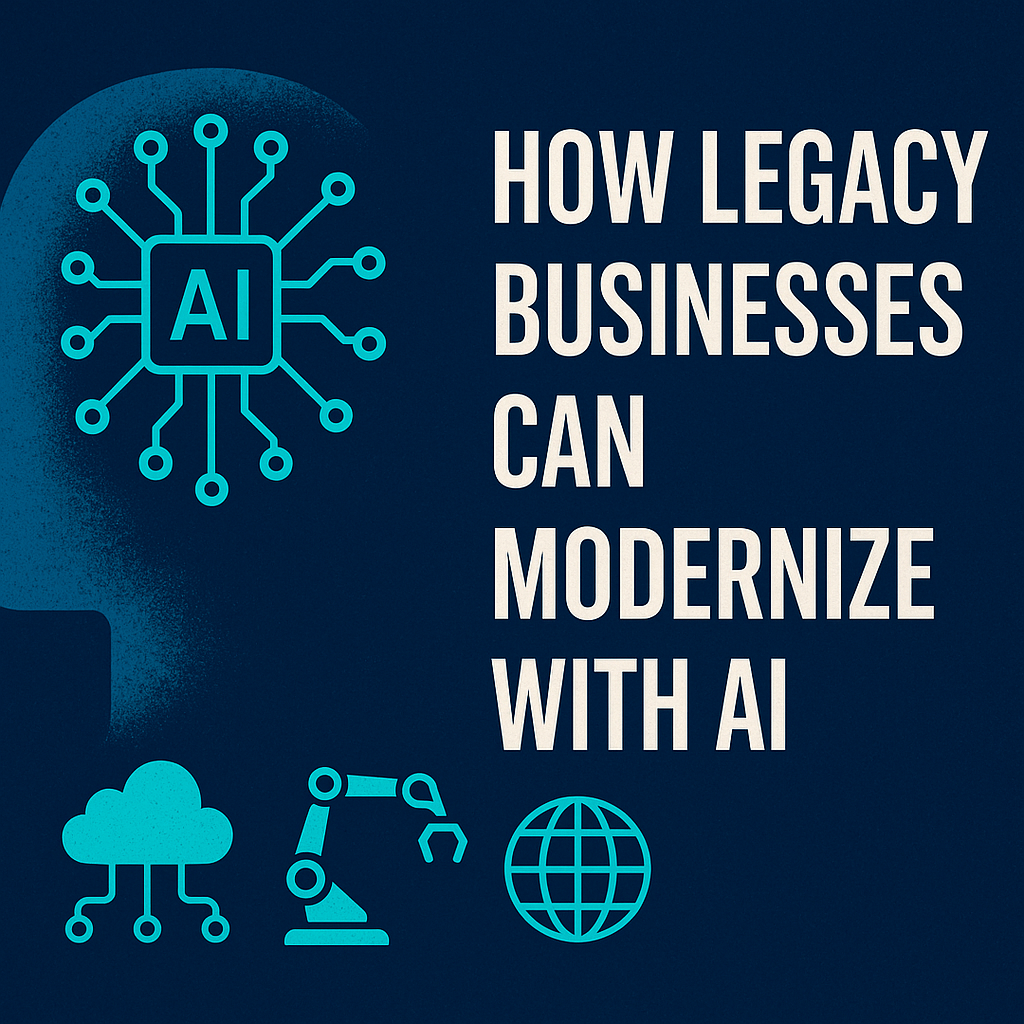In an era where digital-first businesses dominate headlines, legacy organizations often face an existential question: Adapt or become obsolete? The pace of digital transformation has accelerated dramatically over the past few years, driven by disruptive technologies like artificial intelligence (AI), cloud computing, the Internet of Things (IoT), and process automation.
Many legacy businesses built on decades of tradition, manual systems, and customer loyalty find themselves at a crossroads. The question isn’t whether to modernize anymore, but how to do so effectively and sustainably.
This post explores how AI can serve as a key catalyst for legacy business transformation in 2025 and beyond. From revitalizing customer experience to optimizing operations, we’ll walk through practical steps, real-world examples, and strategies that legacy companies can adopt to remain relevant and competitive.
1. Understanding the Need for Transformation
Legacy businesses typically rely on tried-and-tested systems, processes, and customer interactions. But what worked in the past is increasingly being challenged by digitally native competitors who leverage technology to:
- Deliver hyper-personalized experiences
- Automate back-office processes
- Gain deep insights from customer data
- Launch faster, smarter, and leaner
For a legacy business, sticking to outdated technologies not only limits growth but also increases operational costs and reduces agility. AI—when combined with other tech pillars like cloud and IoT—offers a clear path to modernization without necessarily scrapping everything old.
2. Why AI is the Game-Changer for Legacy Enterprises
AI stands at the center of digital transformation because it amplifies human capabilities and automates cognitive tasks that traditionally required human judgment.
Here’s how AI is driving change:
Predictive Insights
AI can process vast amounts of legacy data to identify patterns, trends, and anomalies, leading to better decision-making.
Process Automation
Through Robotic Process Automation (RPA) and machine learning, repetitive tasks can be executed faster, with fewer errors.
Enhanced Customer Experience
AI chatbots, recommendation engines, and virtual assistants are personalizing customer engagement across channels.
Supply Chain Optimization
Legacy manufacturers and retailers are using AI to forecast demand, manage inventory, and reduce waste.
3. Top 10 Digital Transformation Trends in 2025 for Legacy Businesses
If you’re considering modernization, these trends should be on your radar:
1. AI-Augmented Workflows
Instead of replacing humans, AI tools like copilots and automation bots will augment employee productivity, especially in sales, HR, and customer service.
2. Cloud-Native Infrastructure
Cloud migration is no longer optional. Legacy businesses are moving to hybrid or multi-cloud architectures for scalability and cost control.
3. No-Code and Low-Code Platforms
Empowering non-technical employees to build internal tools and workflows is reshaping IT departments.
4. AI-Powered Cybersecurity
AI systems now proactively identify and neutralize threats, essential for outdated infrastructures vulnerable to modern attacks.
5. IoT and Smart Sensors
Industrial legacy businesses are embedding IoT sensors into machinery and logistics to monitor, optimize, and predict system health.
6. Digital Twins
Digital replicas of physical assets and operations allow simulation, experimentation, and performance monitoring in real-time.
7. Hyperautomation
Combining AI, RPA, and data analytics to fully automate end-to-end processes in finance, procurement, and operations.
8. AI Ethics and Governance
With increased AI usage comes a push for transparency, fairness, and regulatory compliance, especially important for legacy businesses transitioning in regulated industries.
9. Voice and Conversational Interfaces
Voice assistants and AI chatbots are modernizing customer service, field support, and internal workflows.
10. Integrated Data Lakes
Businesses are centralizing data from disconnected silos into AI-friendly formats to unlock full data-driven decision-making.
4. Real-World Case Studies of Modernization
General Electric (GE)
Once a hardware-first legacy giant, GE integrated AI and IoT into its industrial units. Its Predix platform enables predictive maintenance and real-time insights for turbines and engines.
Walmart
Walmart revamped its backend with cloud computing and uses AI for inventory control, dynamic pricing, and customer behavior analytics.
Mayo Clinic
This century-old healthcare provider uses AI to analyze patient records, detect disease patterns, and offer telehealth through machine learning.
5. The Roadmap to AI Modernization for Legacy Businesses
Modernizing doesn’t require a full reset. It’s about strategic layering of AI and digital tools over existing infrastructure.
Step 1: Assess Current Infrastructure
Map out current systems, workflows, and digital maturity. Identify inefficiencies and manual dependencies.
Step 2: Set a Digital Vision
Define business goals, such as improving customer service, reducing costs, or launching new digital products.
Step 3: Pilot with Purpose
Start with small, high-impact AI projects—like automating customer service or using machine learning for churn prediction.
Step 4: Build a Data Strategy
Legacy businesses often sit on gold mines of data. Clean, integrate, and structure it for AI readiness.
Step 5: Upskill Your Team
Invest in training programs to educate teams on AI tools, digital ethics, and agile working models.
Step 6: Partner with Tech Providers
Legacy businesses don’t have to build everything in-house. Collaborate with cloud providers, AI startups, and consultants.
Step 7: Focus on Change Management
Internal resistance is often the biggest hurdle. Create a culture of innovation with executive buy-in and continuous communication.
6. Overcoming Common Challenges
Modernizing is not without risks. Here are challenges legacy businesses face—and how to mitigate them:
Challenge: Legacy Tech Debt
Solution: Use APIs and microservices to modernize incrementally without ripping everything out.
Challenge: Skill Gaps
Solution: Upskill internally and hire cross-functional teams with both domain and AI expertise.
Challenge: Fear of AI Replacing Jobs
Solution: Reframe AI as a tool to augment, not replace. Highlight new job roles emerging from AI initiatives.
Challenge: Data Silos
Solution: Implement a data lake and ensure interoperable systems for seamless data access.
7. Future-Proofing Through AI-First Thinking
Digital transformation isn’t a one-time project—it’s an ongoing evolution. By embracing AI, legacy businesses can:
- Gain agility in a fast-changing market
- Serve customers in smarter, faster, and more personalized ways
- Attract next-gen talent interested in innovative work environments
- Reduce waste and maximize efficiency in operations
Ultimately, the question isn’t whether legacy businesses can modernize with AI, it’s how soon they’re willing to act.
Final Thoughts
Modernizing a legacy business in 2025 may seem daunting, but it’s also a tremendous opportunity. AI, paired with cloud and automation, offers a toolkit to bridge the past and future.
As technology becomes more democratized, it’s no longer about having the biggest budget but about having the boldest vision. Whether you’re a manufacturing giant, a retail chain, or a healthcare institution, the time to evolve is now.
Don’t fear the future. Shape it with AI.





